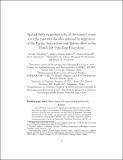Por favor, use este identificador para citar o enlazar a este item:
http://hdl.handle.net/10261/226214COMPARTIR / EXPORTAR:
 SHARE SHARE
 CORE
BASE CORE
BASE
|
|
| Visualizar otros formatos: MARC | Dublin Core | RDF | ORE | MODS | METS | DIDL | DATACITE | |

| Título: | Spatial shifts in productivity of the coastal ocean over the past two decades induced by migration of the Pacific Anticyclone and Bakun's effect in the Humboldt Upwelling Ecosystem |
Autor: | Weidberg, Nicolas; Ospina-Álvarez, Andrés CSIC ORCID ; Bonicelli, Jessica; Barahona, Mario; Aiken, Christopher M.; Broitman, Bernardo R.; Navarrete, Sergio A. | Palabras clave: | Bakun's effect South Pacific Anticyclone Coastal upwelling Primary productivity MODIS ERA-Interim model |
Fecha de publicación: | oct-2020 | Editor: | Elsevier | Citación: | Global and Planetary Change 193: 103259 (2020) | Resumen: | Intensification and poleward expansion of upwelling-favourable winds have been predicted as a response to anthropogenic global climate change and have recently been documented in most Eastern Boundary Upwelling Ecosystems of the world. To identify how these processes are impacting nearshore oceanographic habitats and, especially, long-term trends of primary productivity in the Humboldt Upwelling Ecosystem (HUE), we analysed time series of sea level pressure, wind stress, sea surface and atmospheric surface temperatures, and Chlorophyll-a, as a proxy for primary productivity, along 26°–36° S. Major artisanal and industrial fisheries are supported by phytoplankton productivity in this region and, therefore, identification of long-term trends and their spatial variability is critical for our ability to adapt to and to mitigate the effects of global climate change. We show that climate-induced trends in primary productivity are highly heterogeneous across the region. On the one hand, the well-documented poleward migration of the South Pacific Anticyclone (SPA) has led to decreased spring upwelling winds in the region between ca. 30° and 34° S, and to their intensification to the south. Decreased winds have produced slight increases in sea surface temperature and a pronounced and meridionally extensive decrease in surface Chlorophyll-a in this region of central Chile. To the north of 30° S, significant increases in upwelling winds, decreased SST, and enhanced chlorophyll-a concentration are observed in the nearshore. We show that this increase in upwelling-driven coastal productivity is probably produced by the increased land-sea pressure gradients (Bakun's effect) that have occurred over the past two decades north of 30° S. Thus, climate drivers along the HUE are inducing contrasting trends in oceanographic conditions and primary productivity, which can have far-reaching consequences for coastal pelagic and benthic ecosystems and lead to geographic displacements of the major fisheries. | Versión del editor: | http://doi.org/10.1016/j.gloplacha.2020.103259 | URI: | http://hdl.handle.net/10261/226214 | DOI: | 10.1016/j.gloplacha.2020.103259 | Identificadores: | doi: 10.1016/j.gloplacha.2020.103259 issn: 0921-8181 e-issn: 1872-6364 |
| Aparece en las colecciones: | (IMEDEA) Artículos |
Ficheros en este ítem:
| Fichero | Descripción | Tamaño | Formato | |
|---|---|---|---|---|
| Humboldt_Upwelling_Ecosystem.pdf | 2,91 MB | Adobe PDF |  Visualizar/Abrir |
CORE Recommender
SCOPUSTM
Citations
27
checked on 12-abr-2024
WEB OF SCIENCETM
Citations
21
checked on 21-feb-2024
Page view(s)
104
checked on 17-abr-2024
Download(s)
95
checked on 17-abr-2024
Google ScholarTM
Check
Altmetric
Altmetric
Este item está licenciado bajo una Licencia Creative Commons

